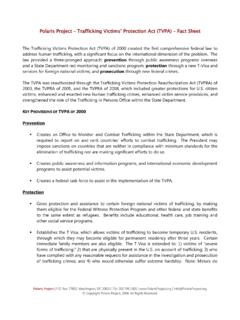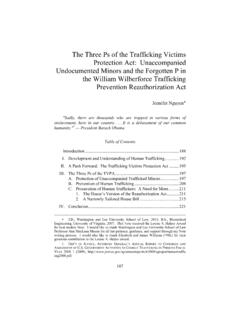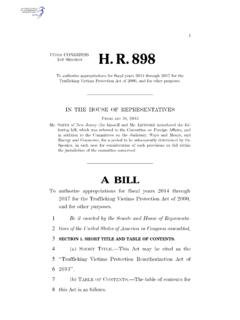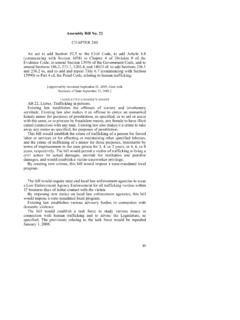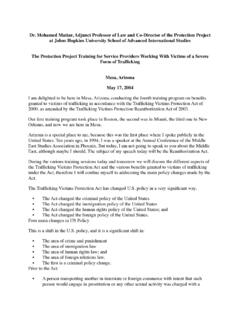Transcription of Domestic Human Trafficking Legislation in the 114th Congress
1 Domestic Human Trafficking Legislation in the 114th Congress Kristin Finklea Specialist in Domestic Security Adrienne L. Fernandes-Alcantara Specialist in Social Policy Alison Siskin Specialist in Immigration Policy April 16, 2015 Congressional Research Service 7-5700 R43917 Domestic Human Trafficking Legislation in the 114th Congress Congressional Research Service Summary Legislation aimed at combating Trafficking in persons (TIP) is a top item on the legislative agenda for the 114th Congress . TIP is of significant interest to the United States as a serious Human rights concern, and it is believed to be one of the most prolific areas of contemporary criminal activity.
2 TIP is both an international and Domestic crime that involves violations of labor, public health, and Human rights standards, as well as criminal law. The Trafficking victims protection Act (TVPA) most recently reauthorized in March 2013 (Title XII of 113-4) is the primary law that addresses Human Trafficking . Domestically, anti-TIP efforts provided under the TVPA include protection for victims , the investigation and prosecution of Trafficking offenses, and education of the public. This report discusses TIP issues that have received legislative action or are of significant interest in the 114th Congress . As Human Trafficking issues intersect with many different policy areas ( , immigration, child welfare, the criminal justice system, missing and exploited youth), Legislation to address Human Trafficking is varied.
3 This is illustrated by the panoply of bills that have recently passed the House. For example, the Human Trafficking Prevention, Intervention, and Recovery Act of 2015 ( 350), Trafficking Awareness Training for Health Care Act of 2015 ( 398), and the Human Trafficking Prioritization Act ( 514), as passed by the House, would address interagency coordination, efficiency, and best practices as they relate to combating Human Trafficking . The Human Trafficking Prevention Act ( 357) and the Human Trafficking Detection Act of 2015 ( 460), as passed by the House, would enhance training for officials to help identify victims of Trafficking . The International Megan s Law to Prevent Demand for Child Sex Trafficking ( 515), as passed by the House, would create a new center in the Department of Homeland Security (DHS) that would be responsible for notifying the destination country of international travel by child-sex offenders, where appropriate.
4 Several other bills, as passed by the House, would strengthen the federal and state responses to Trafficking through a variety of service systems. 246, To Improve the Response to victims of Child Sex Trafficking , would ensure that reports to a federally funded tipline of sexually exploited children can include children who are victims of sex Trafficking . The Enhancing Services for Runaway and Homeless Youth victims for Youth Trafficking Act of 2015 ( 468) would use the Runaway and Homeless Youth program as a vehicle to enhance services to youth who are vulnerable to sex and labor Trafficking . The Strengthening Child Welfare Response to Trafficking Act of 2015 ( 469) would strengthen state child welfare agencies responses to the Trafficking of children.
5 A number of bills would amend criminal justice policy in an attempt to obstruct Human Trafficking . For instance, the Stop Advertising victims of Exploitation Act of 2015 (SAVE Act, 285, as passed by the House), would provide penalties for knowingly advertising, or knowingly selling advertising that offers, certain commercial sex acts. The Stop Exploitation Through Trafficking Act ( 159, as passed by the House, and S. 166, as reported by the Senate Judiciary Committee) would incentivize states to enact safe harbor Legislation which would ensure that children who are found in prostitution would be treated as victims rather than perpetrators and increase restitution amounts for victims .
6 Several pending bills, such as the Justice for victims of Trafficking Act of 2015 ( 181; S. 178), the Stop Exploitation Through Trafficking Act of 2015 ( 159), and the Human Trafficking Prevention, Intervention, and Recovery Act of 2015 ( 350), all as passed by the Domestic Human Trafficking Legislation in the 114th Congress Congressional Research Service House, would adopt a multi-prong approach to anti-TIP efforts, including improving services to victims . For example, 181 and S. 178 would create new grant programs for law enforcement and victims services, and would amend the criminal code (Title 18 of the Code) for certain Trafficking -related activities.
7 S. 178 would also impose an additional $5,000 penalty on anyone convicted of certain Trafficking -related and other offenses and would establish a Domestic Trafficking victims Fund into which revenues from such penalties would be deposited and used to award certain grants authorized by the TVPA or to enhance victims services. Domestic Human Trafficking Legislation in the 114th Congress Congressional Research Service Contents Definition of Human Trafficking .. 2 Select Anti- Trafficking Legislation in the 114th Congress .. 3 Restoring victims : Services and Benefits .. 5 Adequacy of Services for victims .. 5 Certification .. 7 Job Corps Program .. 7 Restitution and Damages.
8 7 Criminal Justice .. 8 Enhanced Financial Penalties .. 8 Reducing Demand .. 9 Cyber Crimes Unit in Immigration and Customs Enforcement .. 9 Domestic Sex Trafficking of Children .. 10 Missing and Exploited Children .. 11 Runaway and Homeless Youth .. 12 Improving Investigations and Prosecutions of Child Abuse .. 13 Response by the Child Welfare System .. 14 Grant Programs for Domestic Minor victims of Sex Trafficking .. 16 Juvenile Justice .. 17 Other Issues .. 17 Inter-agency Coordination/Efficiency .. 17 Training .. 19 Sex Offender Registry .. 20 Tables Table A-1. Active Legislation in the 114th Congress that Addresses Human Trafficking .. 22 Appendixes Appendix.
9 Pending Human Trafficking Bills that Have Received Congressional Action or Are of Significant Congressional Interest .. 22 Contacts Author Contact 26 Domestic Human Trafficking Legislation in the 114th Congress Congressional Research Service 1 he 114th Congress has made fighting Trafficking in persons (TIP) within the United States a legislative TIP is of significant interest to the United States as a serious Human rights concern and a prolific area of contemporary criminal TIP is both an international and Domestic crime that involves violations of labor, public health, and Human rights standards, as well as criminal law. The United States is a source, transit, and destination country for men, women, and children subject to Trafficking in Human Trafficking occurs in every state, and it victimizes both citizens and There are no current, reliable data on the number of individuals trafficked in the United States.
10 However, some have suggested as many as 17,500 may be trafficked into the country each year,5 and perhaps 100,000 citizen children may be victims of Trafficking within the United The Trafficking of individuals within borders is commonly referred to as Domestic Human Trafficking ; it occurs primarily for labor, most often in Domestic service, agriculture, manufacturing, janitorial services, hotel services, construction, health and elder care, hair and nail salons, and strip club dancing. However, more investigations and prosecutions have taken place for sex Trafficking offenses than for labor Trafficking Noncitizens are more susceptible than citizens to labor Trafficking ,8 and more foreign victims9 are found in labor Trafficking than in sex Trafficking .










